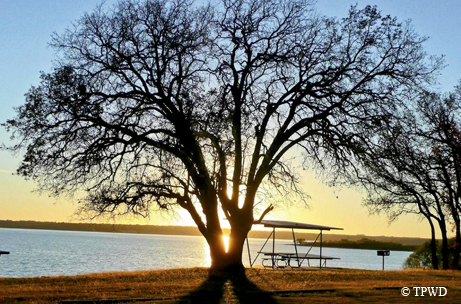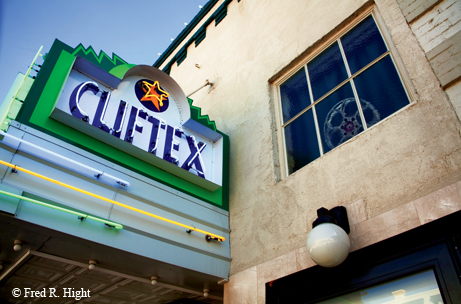
Three for the Road
Destination: Whitney, Meridian, Clifton
Travel time from:
Austin – 2 hours
Brownsville – 7 hours
Dallas – 1.5 hours
Houston – 3.5 hours
San Antonio – 3.25 hours
Lubbock – 4.5 hours
El Paso – 8.25 hours
Whitney, Meridian and Clifton provide natural, historical Central Texas sights.
By Sheryl Smith-Rodgers
Flameleaf sumacs, live oaks, ashe junipers and native grasses blanket the gently rolling hills as we drive along Bosque County Road 4145 northwest of Waco. My husband and I have just embarked on a fall weekend jaunt to three towns (and two state parks) that we’ve never explored — Clifton, Whitney and Meridian.
Set atop a grassy knob, a stone church with a wooden steeple beckons us to stop. We’ve come upon the St. Olaf Lutheran Rock Church, built in 1886 by immigrants who established nearby Norse, the state’s largest Norwegian settlement. Inside, we’re dazzled to find pastel hues of blue, yellow, pink and green gracing walls and ceilings. Scuffed floorboards and wooden pews dulled from use recall long-ago Sunday services when pastors addressed parishioners from the ornately decorated altar.

Norwegian immigrants built St. Olaf Lutheran Rock Church.
Doland Olson, a direct descendant of the original settlers, happens by and graciously shows us the oldest grave in the adjoining cemetery. A cracked tombstone, held together with cement, honors a young woman who died in 1885.
“My grandparents, who came from Denmark and Norway, and my parents are buried here,” he tells us.
We continue east and stop briefly at Our Savior’s Lutheran Church, a steepled edifice completed in 1885 and brick-veneered in 1907. Early Norse settlers worshipped here first. They built the Rock Church soon after to accommodate their growing numbers.
In Clifton, we stop at Los Verdes Restaurante Mexicano for chips, enchiladas and unlimited charro beans, served with smiles galore by our waitress, Yvonne. My husband, James, a history buff, can’t wait for the next destination on our schedule — the Bosque Museum.
“Our mission here is to chronicle the land, people and culture of Bosque County,” says curator Bill Calhoon.
That’s a huge objective, but this relatively small collection of exhibits accomplishes it quite well. Artifacts range from Paleo-Indian and Early Archaic spearheads to pioneer kitchen utensils, blacksmithing tools and a 1850s rocking chair handmade by Cleng Peerson, the “father of Norwegian immigration.”
James lingers by the Horn Shelter Exhibit, which depicts a prehistoric burial site found along the Brazos River in southeastern Bosque County. There, archaeologists in 1970 carefully removed the skeletal remains of a man and young girl, radiocarbon-tested to be some 11,200 years old. The Paleo-Indian site is one of only a few in North America that include skeletal remains and grave items such as turtle shells and coyote teeth.
“Take our picture,” says James, standing next to “Sam,” a bronze bust of how the Horn Shelter man may have looked.
Next we mosey over to Clifton College, a red-bricked 1920s building that houses the Bosque Arts Center. Inside, we find director Jane Scott, who gives us an impromptu tour. First, we peek inside the adjoining Tin Building Theatre, formerly used as a manufacturing warehouse. Then we hop aboard the elevator to see the second-floor art galleries.
“We’ve hosted the Bosque Art Classic, a national juried art show, for nearly 30 years,” Scott says. “This past year, we had 600 entries and hung 150, so it’s quite the big deal here.”
James and I love how the galleries, gift shop and first-floor classrooms still retain remnants from school days long past, such as chalky blackboards and transom windows. We sure envy Clifton folks, who can attend art shows, piano lessons, pottery classes, theater productions and other cultural programs in their own hometown.
We end the day with eggplant Parmigiana, lasagna and buttery garlic rolls at Bella Veta Italian Restaurant near the Arts Center. Delizioso!
Saturday morning, we’re off to Whitney, a short half-hour trip northeast that crosses the Lake Whitney dam. Downtown, we browse a few antique shops. James examines oil lamps while I eye a hanging Christmas tree, fashioned by a local artist from vintage jewelry. (My new bejeweled tree will look stunning over our buffet.)
On Brazos Street, James snaps a photo of me seated on an extremely long, barn-red bench, site of Whitney’s infamous Battle of the Benches in 1949. According to local history, upright womenfolk despised the “whittlin’ and spittin’” old-timers, who routinely occupied the bench. With the mayor’s support, they had the bench removed. Outraged, the old-timers petitioned for an election to get their bench back. They won, 124 to 67.

The sun sets over the lake at Lake Whitney State Park.
Next stop: Lake Whitney State Park, a 775-acre getaway located three miles west of Whitney. In the day-use area, we plunk down at a shaded picnic table, where we eat our sandwiches and enjoy lake views. Nearly 37 square miles big, Lake Whitney appeals to anglers looking to snag bass, crappie and catfish. On weekends, families and youth groups fill up campsites and screened shelters, many of which overlook the lake. Weather permitting, members of the Whitney Area Miniature Aircraft Club often fly their radio-controlled planes at the park’s paved airstrip on weekends.
Uh-oh, I see a dung beetle about to topple into an open socket in the concrete slab at our picnic site. Too late! I dash over and discover oodles of black beetles trapped at the bottom. While I watch, another tumbles in! Perhaps a male’s love-inducing pheromones are drawing in the girls? Whatever the case, no one can climb up the steep sides. So I arrange a stick and some frogfruit as escape ladders. While I watch, several clamber out and fly away.
At the Two Bridges Trail, we meet up with park Superintendent Chris Bishop.
“We don’t have alligators,” quips Bishop, who previously worked at Brazos Bend State Park near Houston, “but we do have an abundance of white-tailed deer, roadrunners, turkeys and other wildlife. In the next few years, we plan to build as much as six miles of new trails.”
As we hike the nearly mile-long wooded loop, I spy yellow bitterweed, broomweed and native grasses in open areas. As the trail name implies, we cross two wooden footbridges.
James and I part ways with Bishop, then we motor over to the Towash Forest Trail, located on the park’s other side. The wide 1.1-mile path cuts through woods, then loops through a grassy meadow that skirts by the lake. Along the shore, nearly dead bagpods, tall and laden with seedpods, rattle in the breeze. Monster grasshoppers wing by, and I stop to photograph a pink mound of fall witchgrass.
For supper, we savor fried catfish and shrimp at the Texas Great Country Café and Pie Pantry in Whitney. Fried corn-on-the-cob as a side? Pretty tasty! The waitress boxes up a slice of pecan brownie pie for later. Sweet!
Back in Clifton, James and I buy tickets to see a movie at the Cliftex Theatre, billed as Texas’ oldest continuously operating theater (it opened in 1916). We love the outdoor neon lights, old-time ticket booth and Art Deco light fixtures. There’s even an intermission, a throwback to our own yesteryears.

The Cliftex Theatre is billed as Texas’ oldest continuously operating theater.
On our way home Sunday morning, we take FM 1991 from Clifton to Meridian. A mile down the country byway, we venture off to cross an old iron bridge over the North Bosque River. Built in 1884, the Clifton Whipple Truss Bridge — a design style patented by civil engineer Squire Whipple — served travelers until a more modern bridge was built in 1941.
In Meridian, downtown businesses and the Renaissance-style courthouse — built in 1886 of quarried limestone — are closed. No problem. We’re eager to tour Meridian State Park, located just a few miles south off Texas Highway 22. The 504-acre park encircles Lake Meridian, a no-wake, 72-acre reservoir perfect for canoeing, kayaking and fishing. Workers with the Civilian Conservation Corps built the park’s stone refectory, roads and other structures in the early 1930s.
“We’re a nesting site for the endangered golden-cheeked warbler from March through June, a huge draw for folks hoping to catch a glimpse of the elusive bird,” says Superintendent Adrian Smith. “People especially love the park’s quiet, laid-back atmosphere and beautiful scenery.”
The heavily wooded roadsides and camping areas astound us as we loop around the park’s east side. Beautiful! Then we drive to the park’s west side and get out at the Shinnery Ridge Nature Trail. For nearly an hour, we meander along the 1.64-mile path that winds through ashe junipers and thickets of scaly-bark oaks.
Two-thirds of the way along, the dirt trail turns to asphalt, and the thick juniper canopies give way to open skies. Brickell-bushes with fringe-tipped yellow flowers remind me of mistflowers in our gardens, and I pause to observe a question mark butterfly warming her wings atop a Texas oak branch.
Heading back to the car, we stop to photograph three black vultures, roosting a short distance away in a dead tree. They eye us warily and then flap off over Lake Meridian, disappearing beyond the treetops. Likewise, we must depart. But we’ll be back, perhaps for a spring weekend jaunt. I hear the wildflowers here are stunning.
Related stories
See more travel stories on TP&W magazine's Travel page

